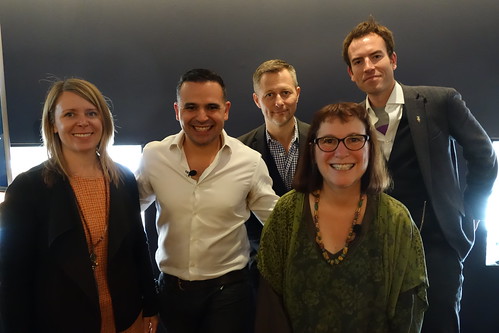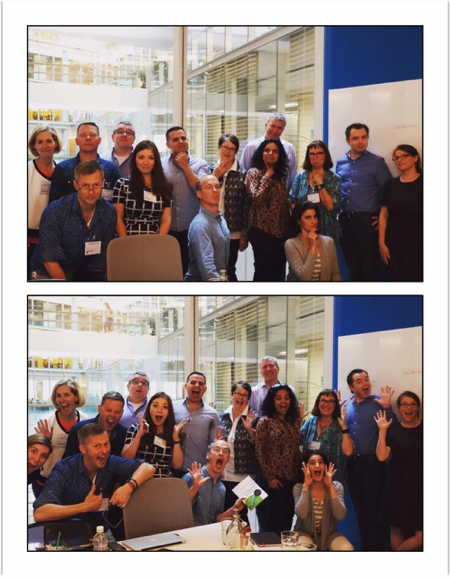
I am just back from spending a few days in London where I keynoted the “Future of Social” Conference hosted by Social Misfits Media with a talk about Gen Z or as they say in the UK, Gen Zed. I also facilitated several workshops for London-based nonprofit CEOs and communications directors on developing a strategy for their leadership profiles on social and internal champions (board, staff, and volunteers).
The first half of the conference featured talks from three platforms that discussed future trends for social good. The speakers included:
- Amanda Kelso, Instagram
- Charles Wells, JustGiving
- Kevin McSpadden, Facebook
This post is a roundup of what I learned from the speakers at the conference and some reflections on the workshops.
Keynote Talk: Gen Z Donors – Future Proofing Your Nonprofit’s Fundraising Strategy
I think the tweet above sums up pretty well one of the main points I was making in my talk about Gen Z. If you want to dig in, you can learn more here:
- Interview in the Guardian
- My blog post with slides and links
- Storify with Tweets and Photos
Conference Speakers: What I Learned
Even though I was little bit nervous waiting to go on stage, I focused on taking notes and putting together a storify of the speaker’s remarks. I was expecting to hear a glorified vendor pitch or a basic 101 about the platforms.
That’s not what happened. Each speaker did an excellent job answering the question, “What does the future of social look like?” Each presenter shared inspiring stories and thoughts about the future of social good on their particular platforms without giving a sales pitch. Carlos Miranda, the host, did a great job facilitating and designing the sessions. Here’s a few notes.
Kevin McSpadden is the director of marketing and brand strategy at Facebook, joining the company 18 months ago. He is working on a social good strategy for Facebook. He said that Facebook is on a mission to make the world more open and connected. “A fully connected world gives people access to life long learning and economic opportunity. Having a voice empowers us to make a better world. Our mission is connection.”
The connectivity of the platform, the person-to-person interaction creates meaning. And while over a billion are connected, they are also working on getting two thirds of the world that doesn’t have internet access connected through an initiative called Internet.org, which is bringing together technology leaders, nonprofits and local communities.
He shared many examples of how social change activists are using the power of connection to make deeper connections and work on solving social change challenges by activating their networks through Facebook. “FB can be a catalyst and lever to tackle wicked problems.” In these three ways
- Boundless communities
- Momentum without limits
- Empower participants and constituents
One of the examples was from an Indian NGO “Clothes Box Foundation” that collects donations of clothing for those living in poverty. They post a photo of the recipient on their Facebook page and tag the donor as a way to say thank you. Another example was of Ryan Lee Cox who was concerned about food insecurity at his high school and used Facebook to organize and fundraise to raise enough money to pay for lunches for students in need.
The call to action: “Harness this resource called “friends” and do you best work on our platform. And together, we will create a better world.” You can learn more about how to use Facebook for social good – there are lots of examples and tutorials and resources in their newly retooled nonprofit and social good Facebook Page.
Instagram
Amanda Kelso, Director of Community at Instagram, talked about the Instagram’s vision: to capture and share the world’s moments. It is a place to unlock the raw, beautiful moments and discuss them. She showed many examples of Instagram’s spirit of community.
@marniethedog, a 12 year old senior dog who was adopted, but diagnosed with an illness that made her head tilt. Her owner reached out to celebrities to take selfies with the dog and posted them on Instagram. The intent was to raise awareness of shelter animals.
@everydayafrica was started by a photographer who wanted to show everyday life in Africa was not just famine, war, and disease. The site shows photos that capture the mundane moments of everyday life in a beautiful way. The account inspired many to copy the concept or become an internet meme.
She shared many, many more examples. She also talked about “Instameets” where people who have Instagram accounts meet up and take a photo walk and post photos. The pairing of meetups, photography, and social platforms is not a new idea. Flickr users started that tradition ten years ago. She shared an example of how charity:water and museums have been using these for engagement of supporters for social good.
I think the single most important thing she said was that photos posted on Instagram don’t have to be perfect, they just have to be human – and that means they can be blurry, noting Beyonce posts a lot of blurry photos. If you want to follow news and updates and user stories from Instagram, subscribe to their blog.
Just Giving
Charles Wells gave an inspiring talk about the power of crowd funding and peer to peer fundraising that the Just Giving Platform enables. His talk was a powerful combination of human stories and data. I had facilitated two workshops at their offices the day before and I noticed on the wall was a monitor with map that showed donations happening in real-time, similar to what I noticed when I visited the data-informed VolunteerMatch. Just Giving has used a lot of data about conversions to help improve the effectiveness of nonprofits running campaigns on their platforms.
Charlie say three things about the future of social media and fundraising that we all should keep in mind:
- People discover new causes as they walk by – Donors who contribute via social media re more interested in the cause, not necessarily the institution or brand. To get better results, focus on the cause and the story versus the institution.
- People express their “good self” online – The key to success in social media is to ensure that incorporate social proofing – and encourage and create ways for people to share what they’re supporting with their donations on their social channels. This creates a virtuous cycle of giving. This is similar to what I found in my research on frequent social media users and giving. He also talked about how people are giving because it is part of expressing who they are, not necessarily as a “consideration.”
- People don’t care where the charity is based – They are seeing a trend that philanthropy via social is border less, especially with integration of mobile, geo location, and one-touch giving features available on their platform.
For more insights about the fundraising, social, and mobile, check out Just Giving’s Blog where they share their research insights on a regular basis.
Workshop/Training Reflections

Before the conference, I facilitated several workshops for nonprofit CEOs and communications or fundraising directors at JustGiving headquarters and hosted by Social Misfits Media. The workshops were about “Leading on Social Platforms,” and the participants were mostly CEOs from nonprofits and their communications or fundraising staff. The session covered strategy and how to align personal brand in service of organizational mission. We also did some work on identifying effective social profiles, authentic leader engagement on social that does go into the uncanny valley, and more.

The conference took place at The Hospital Club, a very cool space for creative and technology people. The room was very long and narrow, creating an intimate space for a fairly large group of people. It did pose a speaking challenge in terms of engaging the audience and making eye contact. I did manage to incorporate interactivity in the session – using “Oprah” mic running techniques and trying to keep eye contact with the different sections of the room.

After my NTC session last year about “Walking as Work,” we set up a group of nonprofit people who are interested in keeping healthy as part of their work. It’s call Take A Walk. My colleague, Rik Panganiban recently shared these tips for staying sane and healthy during conferences – and the advice is good for participants and speakers. So, while in London, I also made time for some walking, taking a walk along the Thames and crossing the London Bridge (which is about 1500 steps).
All in all, this was the perfect combination of learning and connecting with people who care about social media for social good.
